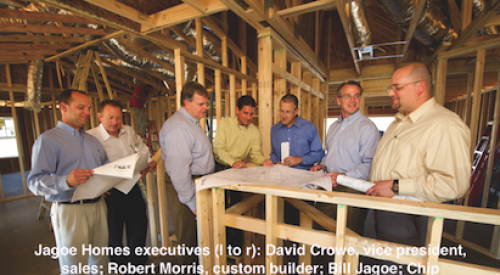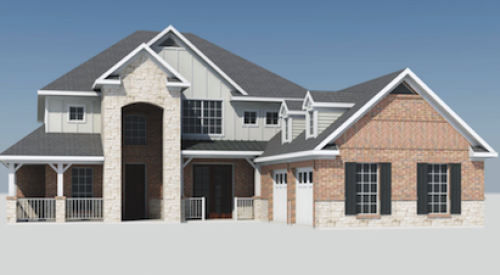|
Scott Sedam: Brad, my first memory of when we met was your office bookcase. You had about every book available on Lean methodology and they were marked up and highlighted. I was impressed.
Brad Jagoe: Five years ago, I began reading books and articles on Japanese companies such as Toyota and following James Womack, the Lean Institute and others. After working with our measurements and process tracking systems, we began working specifically to get our employees and trade partners involved on a higher and deeper level, and then the results really began to flow.
SS: Does it confound you that so many builders still think there's nothing more to be gained from their suppliers and trades beyond hammering them for another price cut? Jagoe Homes clearly looks at its world differently and has the results to prove it.
Bill Jagoe: For years this industry has liked using the term “trade partner,” but for most builders it's just a buzzword, something to call them besides “subs.” But when we got into Lean thinking and processes, and our people began to understand that Lean mattered, we really established that strong trade partnership.
Brad: That led us to our philosophy that we want a small number of extremely capable trades with low turnover. With each new supplier or trade you start back at square one. But in a long-term relationship they have to be extremely competitive and make money. Lean gives both the builder and the trade partners the tools to eliminate waste, reduce cost and remain competitive, by working together.
SS: How difficult was it to bring the trades along with you during Jagoe Homes' conversion to Lean thinking?
Bill: About a quarter got excited about it immediately. Then there's a group that is hesitant but eventually begins to understand. A small number persist in thinking that we are just trying to rebid them -- that everything is somebody else's fault, and let's just solve a problem real quick instead of getting to the root cause.
Brad: We've never replaced anyone specifically because of Lean, but we hold them to extremely high standards. When we have a problem we get to the root issue, identify the solutions and implement the change so we don't repeat it. We are demanding and challenging, but that's the only way we're going to get better.
SS: Any examples?
Brad: We had a plumbing issue where supply lines to faucets had blown off. It was costing the plumber a considerable amount of money and there was a chance he was going to lose his insurance. As we started looking at the root cause of his methods versus how other plumbers did things, we saw that the product he was using was 30 or 40 cents, while the product the other plumbers were using was $3 or $4. He thought he was saving money, but, in this case, spending a little bit of money upfront creates better value and actually costs less in total.
SS: So many builders say, “Oh, we're Lean,” but all they've done is rebid everyone and gone to cheaper products. Lean can only be understood through a total cost perspective, not just initial price.
|
“During the worst year of housing since 1937, we’ve seen a significant increase in market share and we haven’t had a bank tell us to slow down. It’s because of these Lean initiatives.” — Bill Jagoe, Jagoe Homes |
Bill: We had a major U.S. cabinet manufacturer whose crown molding wasn't matching the piece next to it closely enough to satisfy the customer. They would just send extra crown molding so we could try to match it in the field, resulting in a lot of waste. Because of our Lean culture, they brought all their top operations people here to work on solving this problem that was costing $40,000 annually for 200 houses for just one builder.
Brad: Another big thing with Lean is that, although we have tremendously reduced waste, the specs in our houses have actually increased. We have not decreased features within the homes one bit. A lot of our competitors have just cheapened the house. But by eliminating waste, wasted trips and non-value-added items, we've been able to increase the features that customers value.
SS: It's difficult to get builders to recognize the huge cost of wasted or unnecessary trips to the building site, so I'll put you on the spot here, Brad. Do you know how many trips your finish painter is making?
Brad: That's actually a Lean initiative that I'm in charge of! I've been gathering data for months, trying to establish a root cause, because that poor guy gets something from everyone — whether it's a splintered door, an over-nailed piece of trim, dust that's gotten into his work, or damage by the carpet installer. We think it's about $1,000 a house between his return trips and excess labor.
SS: In last month's interview with Jim Deitch of Southern Crafted Homes, he said the biggest problem he faced was getting his own people to come around. Some could not seem to adapt. What's been your experience?
Bill: I don't think we have a person in our company right now — from laborers to architects to salespeople — that is not thinking Lean. We have saved several million dollars the past few years, and everyone is now in the habit of asking, “Does that add value for the customer, or not?”
|
“When we have a problem we get to the root issue, identify the solutions and implement the change so we don’t repeat it. We are demanding and challenging, but that’s the only way we’re going to get better.” — Brad Jagoe, Jagoe Homes |
Brad: And yet we're still sort of in the infancy of our development. As we continue to go with the Lean philosophy, people will develop those skills to identify waste, become better problem-solvers and learn how to implement the solutions better. We are now doing about 350 units annually with 20 percent fewer people than our last experience at this level. We feel we can go to 700 units with this staff.
SS: People often ask about implementation after going through the type of intense, “Lean Kaizen” experience you were involved in. They ask, “How much and how soon?” That is dependent primarily on the commitment of the management team. I cite Jagoe Homes as the best implementer I have seen. How do you do that?
Bill: It comes down to the day-in, day-out focus on Lean … setting the goal and then putting in the plans to meet that target. Along the way there will be bumps in the road and you will have to adjust course. We're demanding about meeting our goals, whether it's a Lean goal, cycle time, quality goal, sales goals or whatever it might be.
SS: To wrap up, what would you say to someone who reads this, maybe listens to the complete interview on HousingZone.com/Lean, and decides they want to implement Lean and emulate companies like Jagoe Homes?
Brad: First, don't wait. A lot of guys want to clean things up first. But Lean is the vehicle to do that. There's a lot of easy money out there, and if they are building any homes they are almost foolish not to do this.
Bill: It's been interesting that during the worst year in housing since 1937, we've seen a significant increase in market share and we haven't had a bank tell us to slow down. It's because of these Lean initiatives. We've increased products and added millions of dollars back into the product by taking out millions of dollars in waste and time. It's just been phenomenal. We decided we weren't going to participate in a recession and we didn't. Now we go forward into 2010 building almost 50 percent more in existing communities. Our economy is still in a recession, but this has actually given us an opportunity that we haven't had in the last 15 years.
SS: That's exciting, and I can attest to the readers that when I visit Jagoe Homes I encounter a bunch of remarkable people who are truly passionate about the home-building business – and Lean. Bill and Brad, thanks.
| Author Information |
| Scott Sedam hosts the Lean Building Forum on HousingZone.com/Lean, where each month he interviews those who are implementing the principles of Lean operations in home building. For the complete transcript and audio of the interviews, visit www.HousingZone.com/Lean. |
|












